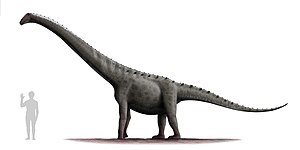Rinconsaurus
| Rinconsaurus | ||||||||||||
|---|---|---|---|---|---|---|---|---|---|---|---|---|

Live reconstruction of Rinconsaurus caudamirus compared to a human size. |
||||||||||||
| Temporal occurrence | ||||||||||||
| Upper Cretaceous ( Turonium to Coniacium ) | ||||||||||||
| 93.9 to 86.3 million years | ||||||||||||
| Locations | ||||||||||||
|
||||||||||||
| Systematics | ||||||||||||
|
||||||||||||
| Scientific name | ||||||||||||
| Rinconsaurus | ||||||||||||
| Calvo & Riga , 2003 | ||||||||||||
| Art | ||||||||||||
|
Rinconsaurus is a genus of sauropod dinosaur from the group of titanosaur , during the Upper Cretaceous ( Turonium or Coniacian lived) South America. Like all sauropods, Rinconsaurus was a large, quadruped (four-footed) herbivore with a long neck and tail.
So far, remains of two adult and one juvenile individuals are known, all of which were discovered at the same site in the Argentine province of Neuquén . The only species , Rinconsaurus caudamirus , was first described by Calvo and Riga in 2003 .
Rinconsaurus was closely related to Muyelensaurus , another titanosaur that was discovered a few kilometers from the Rinconsaurus site. With the description of Muyelensaurus in 2007, the researchers established a new group within the Titanosauria, the Rinconsauria, in which they classify Rinconsaurus and Muyelensaurus .
features
Like the related Muyelensaurus , Rinconsaurus was an unusually slender, medium-sized titanosaur estimated to be 11 meters in length and 2.5 meters at shoulder. Although the skull has only survived in fragments, it is believed to be long and thin, like other titanosaurs. Distinguishing features ( autapomorphies ), by which one can distinguish the genus from other genera, include features on the vertebrae; so were z. B. the vertebral processes of the anterior vertebrae inclined backwards by more than 60 degrees.
Find and naming
The fossils were discovered in 1997 by Gabriel Benítez in Cañadón Río Seco, a site 2 km north of Rincón de los Sauces near the Río Colorado River , and then excavated by the team of Argentine paleontologist Jorge Calvo. Geologically, the site belongs to the Río Neuquén Formation and thus to the Neuquén Group ; the deposits are dated to the Turonian to Coniacian .
The remains consist of vertebrae, tail vertebrae in an anatomical composite, pelvic bones, leg and arm bones and some skull bones (including a jaw with teeth). All bones were associated with one another, and because of the morphological similarity of the same bones, it is assumed that the bone aggregation is monospecific, that is, that all bones belong to the same species. The best preserved bones, a series of connected caudal vertebrae, were found in the "living position" with two iliac bones.
The name Rinconsaurus is derived from Rincón de los Sauces, the city where the bones were found, and from sauros ( Greek ) - "lizard". The specific epithet caudamirus is derived from the Latin words cauda - "tail" and mirus - "amazing", "amazing". The name can thus be freely translated as "dinosaur from Rincón de los Sauces with the amazing tail".
literature
- Jorge O. Calvo , Bernardo J. González Riga: Rinconsaurus caudamirus gen. Et sp nov., A new titanosaurid (Dinosauria, Sauropoda) from the Late Cretaceous of Patagonia, Argentina. In: Revista Geológica de Chile. Vol. 30, No. 2, 2003, ISSN 0378-6617 , pp. 333-353, doi : 10.4067 / S0716-02082003000200011 .
Individual evidence
- ^ Gregory S. Paul : The Princeton Field Guide To Dinosaurs. Princeton University Press, Princeton NJ et al. 2010, ISBN 978-0-691-13720-9 , p. 205, online .
- ↑ a b Jorge O. Calvo, Bernardo J. González-Riga, Juan D. Porfiri: Muyelensaurus pecheni gen. Et sp. nov., a new titanosaur sauropod from the Late Cretaceous of Neuquén, Patagonia, Argentina. In: Arquivos do Museu Nacional. Rio de Janeiro. Vol. 65, No. 4, 2007, ISSN 0365-4508 , pp. 485–504, online (PDF; 1.66 MB) ( Memento of the original from May 31, 2011 in the Internet Archive ) Info: The archive link was inserted automatically and not yet checked. Please check the original and archive link according to the instructions and then remove this notice. .